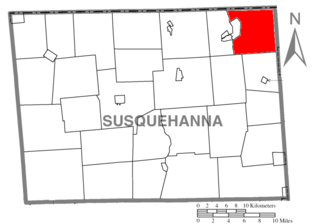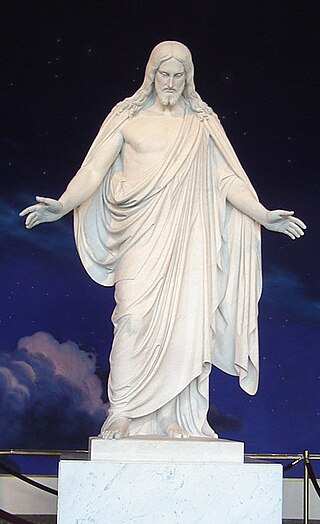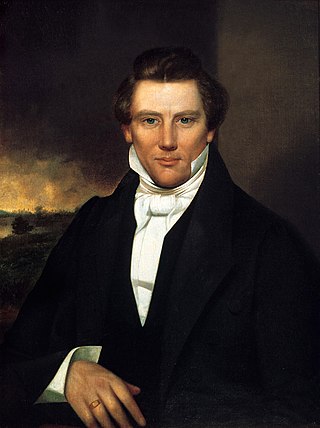
Harmony Township is a township in Susquehanna County, Pennsylvania, United States. The population was 512 at the 2020 census.
In Mormonism, the Melchizedek priesthood, also referred to as the high priesthood of the holy order of God or the Holy Priesthood, after the Order of the Son of God, is the greater of the two orders of priesthood, the other being the Aaronic priesthood.
In Mormonism, the restoration refers to a return of the authentic priesthood power, spiritual gifts, ordinances, living prophets and revelation of the primitive Church of Christ after a long period of apostasy. While in some contexts the term may also refer to the early history of Mormonism, in other contexts the term is used in a way to include the time that has elapsed from the church's earliest beginnings until the present day. Especially in the Church of Jesus Christ of Latter-day Saints "the restoration" is often used also as a term to encompass the corpus of religious messages from its general leaders down to the present.
In the Latter Day Saint movement, priesthood is the power and authority of God given to man, including the authority to perform ordinances and to act as a leader in the church. A group of priesthood holders is referred to as a quorum.

The Aaronic priesthood is the lesser of the two orders of priesthood recognized in the Latter Day Saint movement. The higher being the Melchizedek priesthood. Unlike the Melchizedek priesthood, which is modeled after the authority of Jesus and the Twelve Apostles, the Aaronic priesthood is modeled after the priesthood of Aaron the Levite, the first high priest of the Hebrews, and his descendants. The Aaronic priesthood is thought to be a lesser or preparatory priesthood and an "appendage" of the more powerful Melchizedek priesthood.

The Church of Christ was the original name of the Latter Day Saint church founded by Joseph Smith. Organized informally in 1829 in upstate New York and then formally on April 6, 1830, it was the first organization to implement the principles found in Smith's newly published Book of Mormon, and thus its establishment represents the formal beginning of the Latter Day Saint movement. Later names for this organization included the Church of the Latter Day Saints, the Church of Jesus Christ, the Church of God, the Church of Christ of Latter Day Saints, and the Church of Jesus Christ of Latter Day Saints.

The Latter Day Saint movement is a religious movement within Christianity that arose during the Second Great Awakening in the early 19th century and that led to the set of doctrines, practices, and cultures called Mormonism, and to the existence of numerous Latter Day Saint churches. Its history is characterized by intense controversy and persecution in reaction to some of the movement's doctrines and practices and their relationship to mainstream Christianity. The purpose of this article is to give an overview of the different groups, beliefs, and denominations that began with the influence of Joseph Smith.
The patriarchal priesthood is associated with the patriarchal order found in Mormonism and is especially connected with celestial marriage.

Temple Square is a 10-acre (4.0 ha) complex, owned by the Church of Jesus Christ of Latter-day Saints, in the center of Salt Lake City, Utah. The usage of the name has gradually changed to include several other church facilities that are immediately adjacent to Temple Square. Contained within Temple Square are the Salt Lake Temple, Salt Lake Tabernacle, Salt Lake Assembly Hall, the Seagull Monument, and two visitors' centers. The square was designated a National Historic Landmark District in 1964, recognizing the Mormon achievement in the settlement of Utah.
Priest is a priesthood office in the Aaronic priesthood of denominations within the Latter Day Saint movement, including the Church of Jesus Christ of Latter-day Saints.

The Kirtland Temple is the first temple built by adherents of the Latter Day Saint movement, located in Kirtland, Ohio, and dedicated in March 1836. Joseph Smith, the movement's founder, directed the construction following a series of reported revelations, and the temple showcases a blend of Federal, Greek Revival, and Gothic Revival architectural styles. It was added to the National Register of Historic Places in 1969 and named a National Historic Landmark in 1977. Prior to March 5, 2024, the temple was owned and operated by Community of Christ for over a century before ownership transferred to the Church of Jesus Christ of Latter-day Saints.
In the Church of Jesus Christ of Latter-day Saints, the priesthood is the power and authority to act in the name of God for the salvation of humankind. Male members of the church who meet standards of worthy behavior and church participation are generally ordained to specific offices within the priesthood.

In the Latter Day Saint movement, baptism is recognized as the first of several ordinances (rituals) of the gospel.
William C. Conway was an American neo-Druid and the leader of a mystical sect in the Latter Day Saint movement.

The following outline is provided as an overview of and a topical guide to the Church of Jesus Christ of Latter-day Saints.

The following outline is provided as an overview of and topical guide to the life and influence of Joseph Smith:
Wilford C. Wood, was an American businessman and prominent member of the Latter Day Saint movement who was responsible for acquiring many of the List of historic sites of The Church of Jesus Christ of Latter-day Saints|historic sites]] of the Church of Jesus Christ of Latter-day Saints, including the Nauvoo Temple, Liberty Jail, and Adam-ondi-Ahman.

Restoration of the Aaronic Priesthood: John the Baptist is a 1957 bronze sculpture by Avard Fairbanks, installed in Salt Lake City’s Temple Square, in the U.S. state of Utah. The sculpture commemorates the restoration of the Aaronic priesthood, an event in which, according to Latter-day Saint belief, the lesser order of the power and authority of God was given to male leaders of the church.

Restoration of the Melchizedek Priesthood is a 1960s bronze sculpture by Avard Fairbanks. The artwork was commissioned by the First Presidency of the Church of Jesus Christ of Latter-day Saints for Temple Square in Salt Lake City, Utah, United States. The sculpture commemorates the restoration of the Melchizedek priesthood, an event in which, according to Latter-day Saint belief, the higher order of the power and authority of God was given to male leaders of the church.














